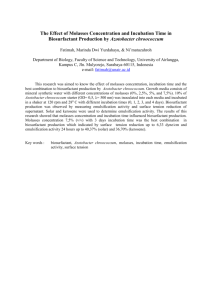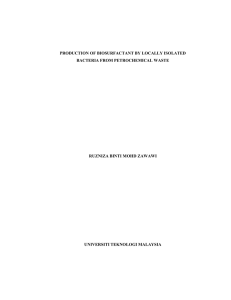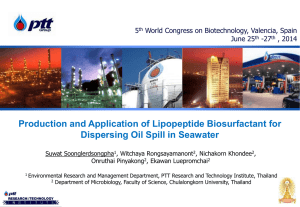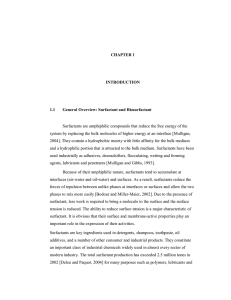vii i ii iii
advertisement
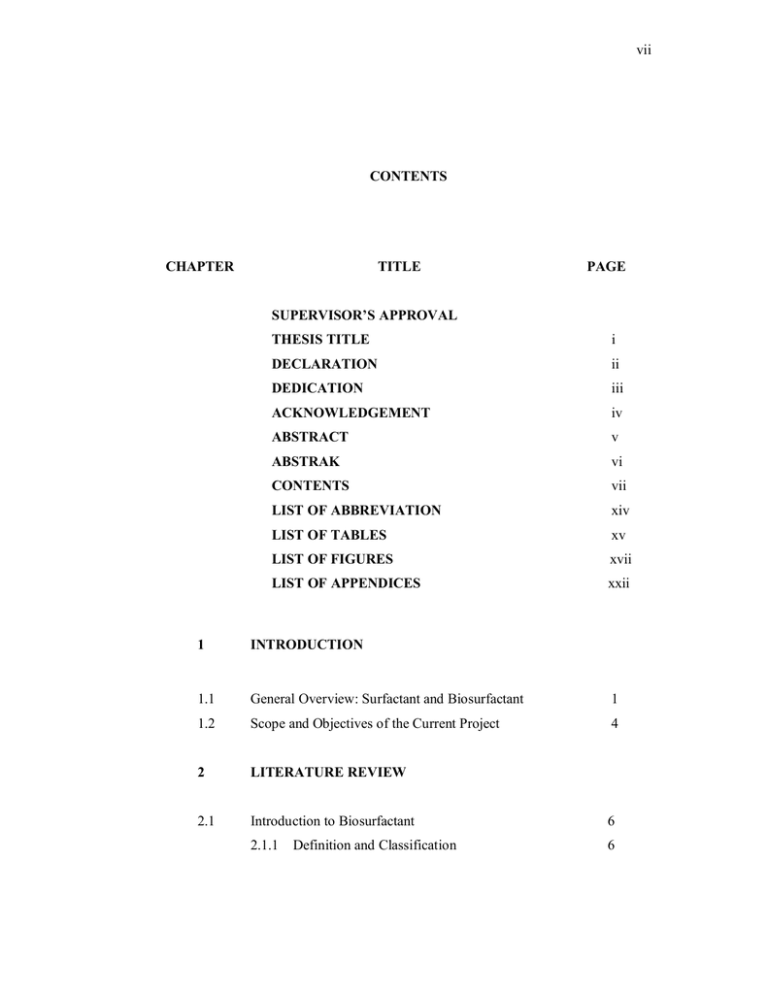
vii CONTENTS CHAPTER TITLE PAGE SUPERVISOR’S APPROVAL THESIS TITLE i DECLARATION ii DEDICATION iii ACKNOWLEDGEMENT iv ABSTRACT v ABSTRAK vi CONTENTS vii LIST OF ABBREVIATION xiv LIST OF TABLES xv LIST OF FIGURES xvii LIST OF APPENDICES xxii 1 INTRODUCTION 1.1 General Overview: Surfactant and Biosurfactant 1 1.2 Scope and Objectives of the Current Project 4 2 LITERATURE REVIEW 2.1 Introduction to Biosurfactant 6 2.1.1 6 Definition and Classification viii 2.1.2 2.2 2.3 2.4 Structure and Properties of Biosurfactant 7 2.1.2.1 Glycolipids 8 2.1.2.2 Lipoproteins and Lipopeptides 9 2.1.2.3 Fatty acids, Phospholipids and Neutral Lipids 10 2.1.2.4 Polymeric Biosurfactants 10 2.1.2.5 Particulate Biosurfactants 11 Screening of Biosurfactant-producing Bacteria 12 2.2.1 Cell Hydrophobicity Test 13 2.2.2 Drop-collapsing Technique 13 2.2.3 Hemolytic Activity 14 2.2.4 Surface Tension Reduction 15 Biosynthesis of Biosurfactant 16 2.3.1 General Features of Biosynthesis 16 2.3.2 Biosynthetic Pathway of Biosurfactant Synthesis 18 2.3.3 Regulation of Biosurfactant Synthesis 20 Production of Biosurfactant 22 2.4.1 Factors Affecting Biosurfactant Production 22 2.4.1.1 Effect of Carbon Source 22 2.4.1.2 Effect of Nitrogen Source 23 2.4.1.3 Effect of Environmental Factors 23 Kinetics of Biosurfactant 24 2.4.2.1 Growth-associated Biosurfactant 25 2.4.2 Production 2.4.2.2 Biosurfactant Production Under Growth- 26 limiting Conditions 2.4.2.3 Biosurfactant Production by Resting or 27 Immobilized Cells 2.4.2.4 Biosurfactant Production in Addition to 28 Precursors 2.5 Extraction of Biosurfactant 28 2.6 Applications and Roles of Biosurfactant 30 2.7 Characteristics of Chemical Surfactant and Biosurfactant 33 2.7.1 34 Advantages and Disadvantages of Biosurfactants in Commercial Application ix 3 GENERAL MATERIALS AND METHODS 3.1 Microorganisms 35 3.1.1 Bacterial Isolates: Origin and Route of Isolation 35 3.1.2 Crude Oil 36 3.2 Media Preparation 38 3.2.1 Liquid Medium 38 3.2.1.1 Ramsay Liquid Medium 38 Solid Media 38 3.2.2.1 Nutrient Agar 38 3.2.2.2 Ramsay Agar 38 3.2.2.3 Blood Agar 39 3.2.2 3.3 3.4 3.5 4 Growth and Maintenance of Bacterial Isolates 39 3.3.1 Inoculum Preparation 39 3.3.2 Culture Maintenance and Storage 39 Analytical Methods 40 3.4.1 Determination of Bacterial Biomass 40 3.4.1.1 Optical Density 40 3.4.1.2 Cell Dry Weight 40 3.4.2 Determination of Glucose Concentrations 40 3.4.3 Surface Activity Measurements 41 3.4.3.1 Surface Tension Measurement 41 3.4.3.2 Interfacial Tension Measurement 41 3.4.3.3 Spreading Tension Measurement 42 Production of Biosurfactant 42 3.5.1 Biosurfactant Extraction 42 3.5.2 Determination of Biosurfactant Dry Weight 43 SCREENING AND CHARACTERIZATION OF BIOSURFACTANT-PRODUCING BACTERIA 4.1 Introduction 44 4.2 Methodology 45 4.2.1 45 Screening of Biosurfactant-producing Bacteria x 4.2.1.1 Bacterial Adherence To Hydrocarbon 45 (BATH) Test 4.2.2 4.2.1.2 Drop-collapsing Test 45 4.2.1.3 Blood Hemolysis Test 46 4.2.1.4 Surface Tension Measurement 46 Characterization of Biosurfactant-producing 47 Isolates 4.3 4.2.2.1 Morphological Analysis 47 4.2.2.2 Biochemical Analysis 47 Results and Discussion 48 4.3.1 Screening of Biosurfactant-producing Bacteria 48 4.3.1.1 Bacterial Adherence To Hydrocarbon 48 (BATH) Test 4.3.2 4.3.1.2 Drop-collapsing Test 50 4.3.1.3 Blood Hemolysis Test 52 4.3.1.4 Surface Tension Measurement 54 Characterization of the Selected Biosurfactant- 55 producing Isolates 4.3.2.1 Colony and Cellular Morphological 55 Characterizations 4.3.2.2 Biochemical Characterization 5 57 PRODUCTION OF BIOSURFACTANT BY PURE AND MIX BACTERIAL CULTURES IN SHAKE FLASKS 5.1 Introduction 5.2 Methodology 5.2.1 58 Optimization of Growth 59 5.2.1.1 Effect of Initial Glucose Concentrations 59 on Growth 5.2.2 5.2.1.2 Effect of Initial pH on Growth 59 5.2.1.3 Effect of Temperature on Growth 60 Biosurfactant Production under the Optimized 60 Growth Condition xi 5.2.3 Effect of Glucose and Crude Oil on 61 Biosurfactant Production 5.2.4 Production of Biosurfactant by Bacterial 61 Mix Cultures 5.3 Results and Discussion 62 5.3.1 Optimization of Growth 62 5.3.1.1 Effect of Initial Glucose Concentrations 62 on Growth 5.3.2 5.3.1.2 Effect of Initial pH on Growth 65 5.3.1.3 Effect of Temperature on Growth 67 Biosurfactant Production under the Optimized 69 Growth Condition 5.3.3 Production of Biosurfactant in Crude Oil- 71 containing Medium 5.3.4 Production of Biosurfactant by Bacterial 79 Mix Cultures 6 PRODUCTION OF BIOSURFACTANT BY STRAIN AB-Cr1 IN BIOREACTOR 6.1 Introduction 84 6.2 Methodology 85 6.2.1 Batch Fermentation 85 6.2.1.1 Effect of Temperature on Biosurfactant 85 Production 6.2.1.2 Effect of Initial Glucose Concentrations on 86 Biosurfactant Production 6.2.1.3 Effect of Controlled pH Condition on 86 Biosurfactant Production 6.2.1.4 Effect of Initial NH4NO3 Concentrations on 87 Biosurfactant Production 6.3 Results and Discussion 87 6.3.1 Effect of Temperature on Biosurfactant Production 87 6.3.2 Effect of Initial Glucose Concentrations on 93 xii Biosurfactant Production 6.3.3 Effect of Controlled pH Condition on 97 Biosurfactant Production 6.3.4 Effect of Initial NH4NO3 Concentrations on 102 Biosurfactant Production 7 CHARACTERIZATION OF CRUDE BIOSURFACTANT 7.1 Introduction 108 7.2 Methodology 109 7.2.1 Emulsification Activity Tests 109 7.2.1.1 Assay of Emulsification 109 7.2.1.2 Assay of Emulsion Stability 109 Critical Micelle Concentration (CMC) 109 7.2.2 Determination 7.3 7.2.3 Stability Studies 110 7.2.4 Thin Layer Chromatography (TLC) 110 7.2.5 Fourier Transform Infrared (FTIR) 111 7.2.6 Fatty Acid Analysis 111 Results and Discussion 112 7.3.1 Emulsification Activities 112 7.3.2 Critical Micelle Concentration (CMC) 114 7.3.3 Stability Studies 116 7.3.4 Thin Layer Chromatography (TLC) 118 7.3.5 Fourier Transform Infrared (FTIR) 120 7.3.6 Fatty Acid Analysis 124 8 GENERAL DISCUSSION AND CONCLUSION 8.1 Conclusion 128 8.2 Suggestion 131 REFERENCES 133 xiii APPENDICES A-G 147 xiv LIST OF ABBREVIATIONS mN/m - Milinewton per meter g/L - Gram per litre mL - Mililitre ºC - Degree Celsius rpm - Rotation per minute nm - Nanometer w/v - Weight per volume v/v - Volume per volume CMC - Critical Micelle Concentration µ - Specific growth rate Pmax - Maximum product concentration Xmax - Maximum biomass concentration Yp/s - Product yield coefficient (g product formed per g substrate utilized) Yp/x - Product yield coefficient (g product formed per g biomass formed) Yx/s - Biomass yield coefficient (g biomass formed per g substrate utilized) et al. - And friends sp. - Species h - Hour NH4NO3 - Ammonium nitrate HCl - Hydrochloric acid Kd - Decay constant xv LIST OF TABLES TABLES TITLE PAGE 2.1 Various biosurfactants produced by different microbes. 6 2.2 Common methods employed for the recovery of 29 biosurfactants. 2.3 Some properties of biosurfactant commonly used in 32 several applications. 2.4 Differences between biosurfactant and synthetic 33 surfactant. 3.1 Origin of bacteria isolated from petroleum-related 37 industries. 4.1 Screening of biosurfactant-producing bacteria using 48 four different methods. 4.2 Results for biochemical tests of the selected isolates. 57 5.1 Specific growth rates and maximum biomass of 65 AB-Cr1 and ETL-Cr1 grown at 37ºC, pH 6.5-6.8 in medium supplemented with various initial glucose concentrations. 5.2 Specific growth rates and maximum biomass of 67 AB-Cr1 and ETL-Cr1 grown in Ramsay medium supplemented with 3mM glucose adjusted to various initial pH. 5.3 Specific growth rates and maximum cell biomass of 68 AB-Cr1 and ETL-Cr1 grown in medium supplemented with 3mM glucose at pH 7.0, incubated at various temperatures. 5.4 Kinetic analysis of growth and biosurfactant 77 xvi production for isolates AB-Cr1 and ETL-Cr1 grown at 37ºC, in medium supplemented with either glucose or crude oil or both glucose and crude oil. 5.5 Kinetic analysis of growth and biosurfactant 82 production for bacterial mix culture system 1:1 (AB-Cr1:ETL-Cr1) grown at 37ºC, in medium supplemented with either glucose or both glucose and crude oil. 6.1 Kinetic analysis for growth and biosurfactant 95 production by AB-Cr1 grown at 37ºC, in medium supplemented with various initial glucose concentrations. 6.2 Kinetic analysis for growth and biosurfactant 101 production by AB-Cr1 grown in medium controlled at various pH values, supplemented with 3mM glucose and incubated at 37ºC. 7.1 Emulsification activity and stabilization of 113 bioemulsifiers by isolated biosurfactants. 7.2 TLC analysis of biosurfactant produced by AB-Cr1 118 and ETL-Cr1 isolates based on the Rf values. 7.3 Relative positions of peaks from GC-MS for methyl esters of fatty acids. 125 xvii LIST OF FIGURES FIGURE 2.1 TITLE PAGE Structure of rhamnolipid produced by Pseudomonas 9 aeruginosa. 2.2 Structure of surfactin produced by Bacillus subtilis. 10 2.3 The amphiphilic structure of a surfactant. 12 2.4 Metabolic pathway of glucose utilization during 19 biosurfactant production 2.5 Schematic illustration showing different types of 25 fermentation kinetics of biosurfactant production. 4.1 -hemolysis on blood agar indicated to the presence 53 of biosurfactant in the culture of AB-Cr1 and ETL-Cr1. 4.2 Colony of AB-Cr1 observed under stereo scan 56 microscope using magnification 50x. 4.3 Colony of ETL-Cr1 observed under stereo scan 56 microscope using magnification 50x. 4.4 Digital photos of bacterial isolates AB-Cr1 and ETL- 56 Cr1 under phase-contrast microscope using magnification 100x with oil immersion. 5.1 Growth curve of AB-Cr1 grown in Ramsay medium 63 pH 6.5-6.8 at 370C as a factor of initial glucose concentrations. 5.2 Growth curve of ETL-Cr1 grown in Ramsay medium 63 0 pH 6.5-6.8 at 37 C as a factor of initial glucose concentrations. 5.3 The specific growth rates of AB-Cr1 and ETL-Cr1 64 xviii grown in Ramsay medium pH 6.5-6.8 at 370C, as a factor of initial glucose concentrations. 5.4 Growth optimization of isolates AB-Cr1 and ETL-Cr1 66 grown at 370C in medium supplemented with 3mM glucose, as a factor of pH. 5.5 Growth optimization of isolates AB-Cr1 and ETL-Cr1 67 grown in medium supplemented with 3mM glucose at pH 7.0, as a factor of temperature. 5.6 Relationship of growth, glucose consumption and 69 biosurfactant production by AB-Cr1 isolate grown in Ramsay medium supplemented with 3mM glucose, adjusted to initial pH 7.0 and incubated at 370C. 5.7 Relationship of growth, glucose consumption and 70 biosurfactant production by ETL-Cr1 isolate grown in Ramsay medium supplemented with 3mM glucose, adjusted to initial ph 7.0 and incubated at 370C. 5.8 Relationship of growth, glucose consumption, pH, 72 surface tension and biosurfactant production for isolates AB-Cr1 and ETL-Cr1 grown in Ramsay medium supplemented with glucose and crude oil, respectively. 5.9 Relationship of growth and biosurfactant production 73 by isolates AB-Cr1 and ETL-Cr1 grown in Ramsay medium supplemented with 5% (v/v) crude oil. 5.10 Relationship between specific growth rates (µ) of 79 isolates AB-Cr1 and ETL-Cr1 with the specific rates of product formation (q p) in medium supplemented with either (i) crude oil, or (ii) both glucose and crude oil, or (iii) glucose. 5.11 Relationship of growth and biosurfactant production by bacterial mix culture system 1:1, grown in Ramsay medium supplemented with glucose and glucose + crude oil. 80 xix 6.1 Maximum cell biomass and biosurfactant production 88 by AB-Cr1 grown in medium supplemented with 3mM glucose, as a factor of temperature. 6.2 Relationship between biosurfactant production, growth 89 and oxygen consumption (A), glucose consumption and pH (B), surface, interfacial and spreading tension (C) by AB-Cr1, grown in medium supplemented with 3mM glucose adjusted to initial pH 7.0 and incubated at 37ºC. 6.3 Surface and interfacial tension reduction of the cell-free 92 culture of AB-Cr1 grown in medium supplemented with 3mM glucose, as a factor of temperature. 6.4 The yield coefficients for biosurfactant and biomass 93 production by AB-Cr1, grown in medium supplemented with 3mM glucose, as a factor of temperature. 6.5 Maximum cell biomass and biosurfactant production 94 by AB-Cr1 grown at 37ºC, as a factor of various initial glucose concentrations. 6.6 Maximum cell biomass and biosurfactant production 97 by AB-Cr1 grown in medium supplemented with 3mM glucose at 37ºC, as a factor of pH. 6.7 Surface tension and interfacial tension reduction of the 99 cell-free culture of AB-Cr1, grown in medium supplemented with 3mM glucose at 37ºC, as a factor of pH. 6.8 The relationship between biosurfactant production, 100 growth and oxygen consumption (A), surface and interfacial tension (B) by AB-Cr1 grown in medium at controlled pH 7.0 and incubated at 37ºC. 6.9 Maximum biomass and biosurfactant production 103 by AB-Cr1 grown in medium supplemented with 3mM glucose at 37ºC, as a factor of various initial NH4NO3 concentrations. 6.10 The relationship between biosurfactant production, 104 xx growth and oxygen consumption (A), surface and interfacial tension (B), by AB-Cr1 grown in medium supplemented with 15mM NH4NO3 and incubated at 37ºC. 6.11 The yield coefficients for biosurfactant and biomass 106 production by AB-Cr1 grown in medium supplemented with 3mM glucose and incubated at 37ºC, as a factor of various initial NH4NO3 concentrations. 7.1 Effect of pH on the activity of the emulsifier 112 produced by AB-Cr1 and ETL-Cr1 isolates. 7.2 Schematic diagram of the variation of surface tension, 114 interfacial tension and the CMC point with surfactant concentration. 7.3 Surface tension of a solution against the concentration 115 of the biosurfactant produced by AB-Cr1 and ETLCr1, grown in medium supplemented with glucose as sole source of carbon. 7.4 Surface tension of a solution against the concentration 116 of the biosurfactant produced by AB-Cr1 and ETLCr1, grown in medium supplemented with glucose and crude oil. 7.5 The pH stability test of biosurfactant produced by AB- 117 Cr1 and ETL-Cr1 grown in medium supplemented with glucose, based on the change of surface tension values. 7.6 Thermal stability test of biosurfactant produced by 117 AB-Cr1 and ETL-Cr1 grown in medium supplemented with glucose, based on the change of surface tension values. 7.7 Infrared spectrum of the surface-active fraction 120 extracted from culture of AB-Cr1 grown in medium supplemented with glucose as the sole source of carbon. 7.8 Infrared spectrum of the surface-active fraction extracted from culture of ETL-Cr1 grown in 121 xxi medium supplemented with glucose as the sole source of carbon. 7.9 Infrared spectrum of the surface-active fraction 122 extracted from culture of AB-Cr1 grown in medium supplemented with both glucose and crude oil as carbon sources. 7.10 Infrared spectrum of the surface-active fraction 123 extracted from culture of ETL-Cr1 grown in medium supplemented with both glucose and crude oil as carbon sources. 7.11 GC-MS chromatogram of fatty acid methyl ester 124 from a culture medium of AB-Cr1. 7.12 GC-MS chromatogram of fatty acid methyl ester 125 from a culture medium of ETL-Cr1. 7.13 Structure of pentadecanoic acid. 126 7.14 Structure of octadecanoic acid. 126 7.15 Structure of heptadecanoic acid. 126 7.16 Mass spectrum of pentadecanoic acid from a 127 culture of AB-Cr1. 7.17 Mass spectrum of octadecanoic acid from a 127 culture of AB-Cr1. 7.18 Mass spectrum of heptadecanoic acid from a culture of ETL-Cr1. 127 xxii LIST OF APPENDICES APPENDIX TITLE PAGE A Graft OD600 versus cell biomass 147 B Glucose standard curve 148 C Biochemical characterization methods 149 D Production of biosurfactant and surface tension 161 reduction in the medium grown with AB-Cr1 isolate E Relationship of growth, glucose consumption and 162 biosurfactant production by bacterial mix culture system 1:1, grown in Ramsay medium supplemented with glucose and glucose + crude oil F Determination of decay constant 163 G Mass spectrums of fatty acid methyl esters from 164 the culture of AB-Cr1 and ETL-Cr1 isolates.
